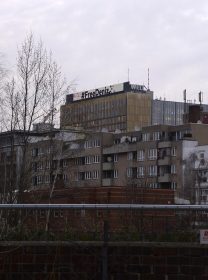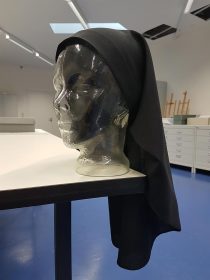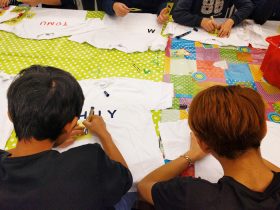
View from the Academy of the Jewish Museum Berlin towards the Springer building with the lit-up sign, #FreeDeniz; Jewish Museum Berlin, photo: Stefanie Haupt
As I leave my office at the Jewish Museum Berlin, emerging from the W. Michael Blumenthal Academy onto the street, the hashtag “#FreeDeniz” beams towards me from an illuminated black-on-turquoise-green display on the Axel Springer building. The first time I saw it, I was cheered by the signal that the publishing house Axel Springer SE* was calling for the release of Die Welt’s correspondent in Turkey, Deniz Yücel. But each day seeing the display has gotten sadder. I’ve known Deniz Yücel since 2003, when — together with other German- and Turkish-speaking Berliners — he organized bilingual protests against the bomb attacks on the two Istanbul synagogues, Neve Shalom and Beth Israel, on November 15 of that year. Twenty-four people were killed in those attacks and at least 300 wounded.
Deniz and I haven’t had contact for quite awhile. But since mid-February, through the news of his imprisonment for “terrorist propaganda” and the car procession protests that followed it, as well as conversations with friends and of course the illuminated sign, memories from the period in 2003 and 2004 when we interacted almost weekly having been coming back. → continue reading
A Visit with Sister Katharina at Karmel Berlin

Sister Katharina donated this veil to us for our exhibition; Jewish Museum Berlin, photo: Katharina Erbe.
Covering one’s head has almost entirely disappeared from Christian women’s devotional practice. In Germany, you only actually see veils on the sisters of Catholic religious orders. In preparing for the exhibition Cherchez la femme (more about it on our website) we all agreed early on that we wanted a nun’s veil.
So I set out for Karmel Regina Martyrum in the northern part of Berlin’s Charlottenburg district, a convent of Discalced (or Barefoot) Carmelites. The convent’s wardrobe mistress, Sister Katharina, greeted me at the door. After some discussion, her view on the matter emerged as fairly sober: some people may ascribe specific spiritual meaning to certain items of clothing but it was very personal issue. In any one community you can meet with a wide variety of attitudes and practices.
Our conversation about the meaning of their religious dress began with Sister Katharina sharing an anecdote: → continue reading
Workshops for young refugees

Whether in Hebrew, Arabic, or German, there are lots of ways to write one’s name; photo: private
What’s written in a Jewish marriage contract? As a minority, how do you secure your civil rights? And why is Hanukkah celebrated for eight days? My work as a guide at the Jewish Museum isabout how to coax stories from objects on display — but also about language. The first thing I did when I began working here about four years ago was to look up how to say “ruminants with cloven hooves” in French. You need to have this phrase at the ready if you want to explain Jewish dietary laws to a group of French museum visitors. My French didn’t help much, however, when I led the first workshops in August of 2016 for Welcome Classes. → continue reading


